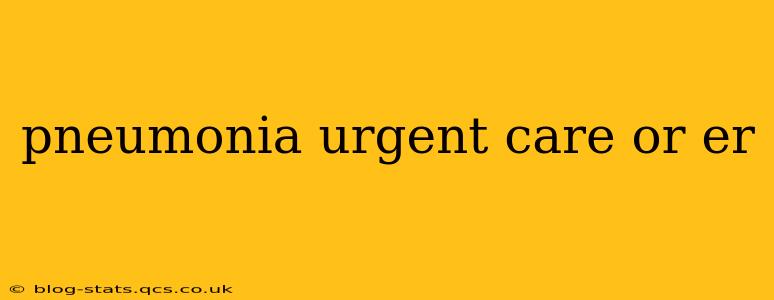Pneumonia, an infection causing inflammation in the air sacs of one or both lungs, can range from mild to life-threatening. Knowing when to seek urgent care versus emergency room treatment is crucial for optimal recovery. This guide clarifies the differences and helps you make informed decisions about your healthcare.
What are the Symptoms of Pneumonia?
Before deciding where to go, understanding pneumonia's symptoms is essential. Common signs include:
- Cough: Often producing phlegm (mucus) that may be green, yellow, or even bloody.
- Fever: High temperature, chills, and sweating.
- Shortness of breath: Difficulty breathing, rapid breathing, or wheezing.
- Chest pain: Sharp pain that worsens with deep breaths or coughs.
- Fatigue: Extreme tiredness and weakness.
- Nausea, vomiting, or diarrhea: These symptoms are more common in bacterial pneumonia.
When Should I Go to Urgent Care for Pneumonia?
Urgent care is a suitable option for pneumonia symptoms if your condition is relatively stable and not rapidly worsening. Consider urgent care if you experience:
- Mild to moderate symptoms: A persistent cough with some phlegm, mild fever, and manageable shortness of breath.
- Stable vital signs: Your heart rate, breathing rate, and blood pressure are within acceptable ranges.
- No difficulty breathing: You can breathe comfortably, even if you are slightly short of breath.
- You can reach urgent care relatively quickly: Delayed access to urgent care might necessitate a different approach.
When Should I Go to the Emergency Room (ER) for Pneumonia?
Emergency room treatment is vital for severe pneumonia cases or rapidly deteriorating conditions. Head to the ER if you experience:
- Severe shortness of breath: Difficulty breathing even at rest, feeling suffocated, or blueish discoloration of the lips or fingertips (cyanosis).
- High fever: A very high temperature that doesn't respond to over-the-counter medication.
- Rapid heart rate: A significantly elevated heart rate.
- Confusion or disorientation: Mental changes indicate a severe infection that may require immediate hospitalization.
- Chest pain: Severe chest pain that makes it difficult to breathe.
- Coughing up blood: This is a serious sign requiring immediate medical attention.
- Existing health conditions: Individuals with compromised immune systems, heart disease, or lung disease are at higher risk of severe pneumonia complications and should seek ER care if symptoms arise.
What Happens at Urgent Care vs. the ER for Pneumonia?
At urgent care, you can expect a physical examination, chest X-ray (possibly), and potentially blood tests to diagnose the pneumonia and determine its severity. Treatment might involve antibiotics (if bacterial), rest, and fluids.
The emergency room offers more comprehensive care. You can expect a thorough physical exam, blood tests, chest X-ray, and potentially other diagnostic tests like arterial blood gas analysis. The ER can provide immediate treatment for severe symptoms, including oxygen therapy, intravenous fluids, and medication. Hospitalization may be necessary for severe cases.
How is Pneumonia Diagnosed?
Pneumonia is typically diagnosed through a combination of methods:
- Physical examination: Listening to your lungs with a stethoscope to detect crackling or wheezing sounds.
- Chest X-ray: This imaging test reveals inflammation and fluid buildup in the lungs.
- Blood tests: Help determine the type of infection (bacterial, viral, or fungal). Complete blood count (CBC) checks for infection markers.
- Sputum culture: A sample of your phlegm is tested to identify the specific bacteria or virus.
Can Pneumonia Be Prevented?
While not entirely preventable, you can significantly reduce your risk through these measures:
- Vaccination: The pneumococcal vaccine protects against several pneumonia-causing bacteria. The flu vaccine also helps, as influenza infections can increase pneumonia risk.
- Healthy lifestyle: A balanced diet, regular exercise, and sufficient sleep strengthen your immune system.
- Smoking cessation: Smoking severely damages the lungs and increases susceptibility to respiratory infections.
- Hand hygiene: Frequent handwashing helps prevent the spread of respiratory viruses and bacteria.
What is the Treatment for Pneumonia?
Treatment depends on the type and severity of pneumonia. Bacterial pneumonia is usually treated with antibiotics. Viral pneumonia often requires supportive care, focusing on rest, fluids, and symptom management. Fungal pneumonia requires antifungal medication.
Remember, this information is for general guidance only. Always consult a healthcare professional for diagnosis and treatment of any medical condition. Early intervention significantly improves the outcome of pneumonia. Don't hesitate to seek medical attention if you're concerned about your symptoms.
